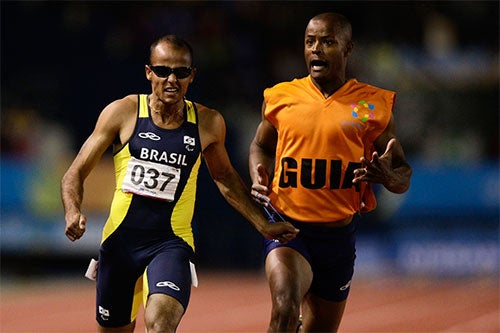
Parapan Am Games: Vision scientist levels the playing field
The visual demands of different sports are unique. Understanding how vision impacts performance is critical to ensuring athletes are grouped fairly, says Waterloo vision scientist

The visual demands of different sports are unique. Understanding how vision impacts performance is critical to ensuring athletes are grouped fairly, says Waterloo vision scientist
By Victoria Van Cappellen Faculty of ScienceWith visually impaired athletes competing in everything from cycling to judo at the 2015 Parapan Am Games in Toronto, spectators may wonder how organizers keep the competition fair for all athletes.
How do athletes know they are competing against others who share a similar visual impairment? How important, for example, are certain types of vision for each sport?

GUADALAJARA, MEXICO - NOVEMBER 16: Lucas Padro of Brazil competes in Men's 200m - T11 during the 2011 Parapan American Games at Telmex Athletics Stadium on November 16, 2011 in Guadalajara, Mexico. Photo credit: Buda Mendes/LatinContent/Getty Images
University of Waterloo researcher, Dr. Kristine Dalton, is working with the International Paralympic Committee (IPC) to help develop new sport-specific visual classification systems for competitors.
Dalton, a professor and optometrist in the School of Optometry & Vision Science in the Faculty of Science, is collecting data from elite Parapan Am athletes to help develop a new classification system that she hopes will level the playing field for visually impaired athletes.
“We want to see athletes win because they’re the best athletes, not because their impairment is greater or lesser than the impairments of their competitors” says Dalton, who established Waterloo’s Sports Vision Clinic. “The aim of this classification research is to minimize the impact of the impairment on the outcome of competition.”
Currently, visually impaired athletes are classified into three groups based on a medical definition of legal blindness produced by the World Health Organization in the 1970s. However, Dalton says there’s a need to determine what visual skills are important for winning in each individual sport.
“You want the classes to be fair and specific for the sport and know where to draw the lines between groups or classes, because we don’t really know how vision impacts the performance,” she says.
For example, in running events on the track, athletes need to have the ability to judge depth, to see where their opponents are on the track, as well as good peripheral vision to stay in their lanes. Right now, we don’t know if it is it better for a runner to have to have normal peripheral vision and poor visual acuity or good visual acuity with restricted peripheral vision (tunnel vision); once we figure out if there is an advantage to have one condition over another, we will be able to define new classification groups for fair competition.”
A sports-specific functional vision classification should help enhance the competition at the games.
In addition to using traditional testing methods, Dalton and her team are introducing new vision tests like a dynamic visual acuity chart, where the letters athletes are trying to read move around. “We want the classification to represent the movements the athletes do,” says Dalton. “Pretty quickly you realize the visual demands for each sport, like shooting, football, running a marathon and judo, are all very different.”
The vision tests she will help develop need to be short, portable and easy to implement if they are going to be used in large international competitions around the world. She plans on looking at a large variety of tests and then choosing which ones most accurately represent the visual demands of individual sports.
Her research is in collaboration with the IPC research team at the University of Amsterdam, which hosts one of three IPC classification research and development centres around the world specializing in the visually impaired criteria for the new IPC Classification Code.
Dalton plans to continue her research this winter, learning more about vision and its importance for alpine skiing and snowboarding athletes.
The Paralympic sport movement has grown since the original games were held for veterans after the Second World War. The 2015 Toronto Parapan Am Games is the largest Parapan Am competition to date and runs from August 7th to August 15th.

Read more
Meet five exceptional Waterloo graduate students crossing the convocation stage as Class of 2025 valedictorians

Read more
From co-op to startup: Waterloo students develop an AI platform that uses real-time data for wildfire prediction and early prevention

Read more
The medal honours outstanding individuals across Canada who have made significant contributions to their communities
The University of Waterloo acknowledges that much of our work takes place on the traditional territory of the Neutral, Anishinaabeg, and Haudenosaunee peoples. Our main campus is situated on the Haldimand Tract, the land granted to the Six Nations that includes six miles on each side of the Grand River. Our active work toward reconciliation takes place across our campuses through research, learning, teaching, and community building, and is co-ordinated within the Office of Indigenous Relations.